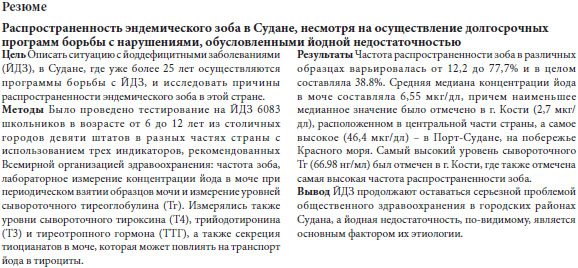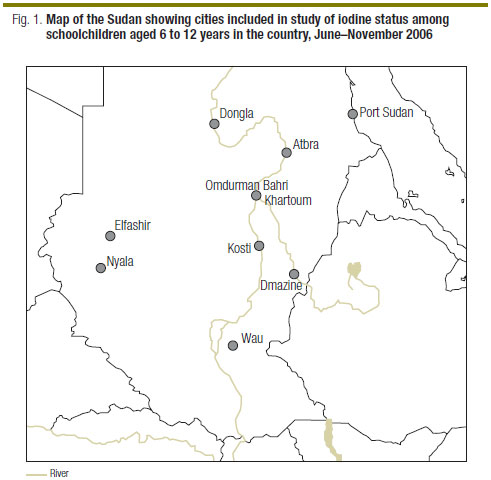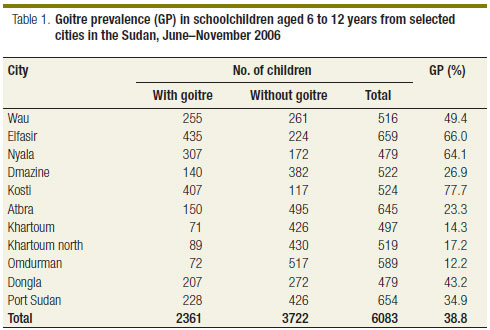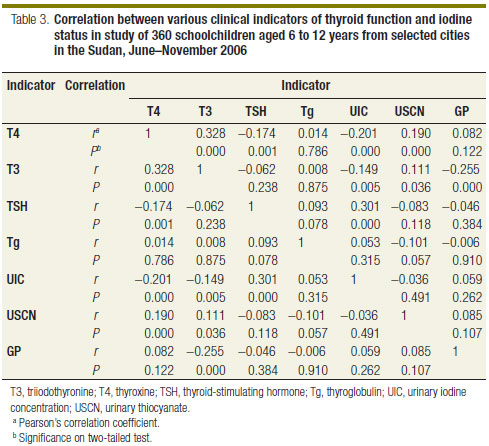RESEARCH
Endemic goitre in the Sudan despite long-standing programmes for the control of iodine deficiency disorders
Goitre endémique au Soudan malgré les programmes permanents de contrôle des troubles dus à la carence en iode
Persistencia del bocio endémico en Sudán pese a la aplicación desde hace tiempo de programas para controlar los trastornos por deficiencia de yodo
Abdel Monim MH MedaniI,*; Abdelsalam A ElnourII; Amal M SaeedIII
ISudan Atomic Energy Commission, Algamaa Street, PO Box 3001, Khartoum, Sudan
IICollege of Medicine, University of Dammam, Dammam, Saudi Arabia
IIIFaculty of Medicine, University of Khartoum, Khartoum, Sudan
ABSTRACT
OBJECTIVE: To describe the status of iodine deficiency disorders (IDDs) in the Sudan more than 25 years after the initiation of IDD control programmes and to explore the causes of endemic goitre in the country.
METHODS: Testing for IDDs was carried out in 6083 schoolchildren 6 to 12 years of age from the capital cities of nine states in different areas of the country using the three indicators recommended by the World Health Organization: the prevalence of goitre, laboratory measurements of urinary iodine concentration in casual urine samples and serum thyroglobulin (Tg) levels. Serum levels of thyroxine (T4), triiodothyronine (T3) and thyroid-stimulating hormone (TSH), as well as urinary secretion of thiocyanate, which can affect the transport of iodine into thyrocytes, were also measured.
FINDINGS: The prevalence of goitre in the different samples ranged from 12.2% to 77.7% and was 38.8% overall. The overall median urinary iodine concentration was 6.55 µg/dl, with the lowest median value having been found in Kosti city (2.7 µg/dl), situated in the centre of the country, and the highest (46.4 µg/dl) in Port Sudan, on the Red Sea coast. The highest mean serum Tg level (66.98 ng/ml) was found in Kosti city, which also had the highest prevalence of goitre.
CONCLUSION: IDDs still constitute a public health problem throughout urban areas in the Sudan and iodine deficiency appears to be the main etiological factor involved.


RÉSUMÉ
OBJECTIF: Décrire l'état des troubles dus à la carence en iode (IDD, Iode Deficiency Disorder) au Soudan, plus de 25 ans après le début des programmes de contrôle des IDD, et explorer les causes de goitre endémique dans le pays.
MÉTHODES: Des tests de carence en iode ont été menés sur 6083 écoliers de 6 à 12 ans dans les capitales de neuf États situés dans différentes régions du pays en utilisant les trois indicateurs recommandés par l'Organisation Mondiale de la Santé : la prévalence du goitre, des mesures en laboratoire de la concentration en iode sur des échantillons occasionnels d'urine et les niveaux de thyroglobuline sérique (Tg). Ont été également mesurés les taux sériques de thyroxine (T4), de triiodothyronine (T3) et de l'hormone de stimulation de la thyroïde (TSH) ainsi que la sécrétion urinaire de thiocyanate susceptibles d'affecter le transport de l'iode dans les thyrocytes.
RÉSULTATS: La prévalence du goitre dans les différents échantillons, de 12,2 % à 77,7 %, était globalement de 38,8 %. La concentration médiane d'iode dans l'urine était de 6,55 µg/dl, avec la valeur médiane la plus basse relevée à Kosti (2,7 µg/dl), dans la région centrale du pays, tandis que la valeur médiane la plus forte (46,4 µg/dl) a été relevée à Port Soudan, sur la côte de la mer Rouge. Le plus haut taux moyen de Tg (66,98 ng/ml) a été relevé dans la ville de Kosti, qui a également la plus haute prévalence de goitre.
CONCLUSION: Les IDD constituent encore un problème de santé publique dans les zones urbaines du Soudan et la carence en iode semble être le principal agent étiologique impliqué.

RESUMEN
OBJETIVO: Describir el estado de los trastornos por deficiencia de yodo (TDY) en Sudán más de 25 años después de poner en marcha los programas de control de los TDY y descubrir las causas del bocio endémico en el país.
MÉTODOS: Se realizaron las pruebas de TDY a 6083 alumnos de entre 6 y 12 años procedentes de las capitales de nueve estados en diversas zonas del país empleando los tres indicadores recomendados por la Organización Mundial de la Salud: la prevalencia del bocio y las mediciones realizadas en laboratorio de la concentración urinaria de yodo en muestreo casual de orina y de la concentración sérica de tiroglobulina (Tg). También se midieron las concentraciones séricas de tiroxina (T4), triyodotironina (T3) y tirotropina (TSH); así como la secreción urinaria de tiocianato, que puede afectar al transporte de yodo a los tirocitos.
RESULTADOS: La prevalencia de bocio en las diversas muestras osciló desde un 12,2% a un 77,7% y fue en total de un 38,8%. La media global de concentración urinaria de yodo fue de 6,55 µg/dl. La media más baja se registró en la ciudad de Kosti (2,7 µg/dl), situada en el centro del país, y la más elevada (46,4 µg/dl), en Puerto Sudán, en la costa del Mar Rojo. La concentración sérica más elevada de Tg (66,98 ng/ml) se registró en la ciudad de Kosti, donde también se registró la mayor prevalencia de bocio.
CONCLUSIÓN: Los TDY siguen siendo un problema de salud pública en las zonas urbanas de Sudán, y la deficiencia de yodo parece ser el principal factor etiológico implicado.
Introduction
In the Sudan, the period from the early 1980s to the mid 1990s witnessed substantial activity in connection with iodine deficiency disorders (IDDs) in the form of epidemiological and etiological studies and assessments of the effects of different interventions.1-7 The total prevalence of goitre reported in those studies ranged from 13% in the eastern city of Port Sudan and 17% in Khartoum state, to 78% in the central region and 87% in Darfur, in the west. According to a national study conducted in 1997, the overall prevalence of all types of goitre was 22%8 and prevalence figures ranged from 5% in the city of Khartoum to 42% in the Upper Nile region. It has been estimated that every year more than 200 000 children born in the Sudan are at risk of iodine deficiency9 and that 3% of those children may develop cretinism, while 10% may experience severe intellectual impairment and 87% less severe intellectual disability.
Various etiological factors in addition to iodine deficiency contribute to goitre endemicity in the Sudan.1-3,5,7 They include vitamin A deficiency and protein-energy malnutrition, both of which can affect thyroid function, and the very high consumption of pearl millet, which contains thiocyanate, a goitrogenic substance.
Although IDD control programmes in the form of distribution of iodized oil capsules and iodized sugar and the universal salt iodization strategy, were launched in the Sudan as early as the mid 1970s,5,10,11 in 2006, when this study was conducted, no progress in implementation had been made.9 Indeed, most iodine supplementation programmes, if not all, had ceased to exist, and only 1% of all Sudanese households had access to iodized salt, according to estimates by the United Nations Children's Fund (UNICEF).12 A more recent situational analysis has shown that IDDs still affect children and women throughout the Sudan and that no policy supporting universal salt iodization is in place.13 Thus, the aim of this study is to evaluate the current status of IDDs in the Sudan and to provide baseline impact indicators for future IDD control programmes. The study also seeks to respond to the 2005 World Health Assembly resolution (WHA58.24) mandating countries to report on their IDD situation every three years.
Methods
We performed a descriptive cross-sectional study to investigate the burden of IDDs using three indicators recommended by the World Health Organization (WHO): goitre prevalence, median urinary iodine concentration (UIC) (determined from casual urine samples) and mean serum thyroglobulin (Tg) levels. Mean serum levels of thyroxine (T4), triiodothyronine (T3) and thyroid-stimulating hormone (TSH) were also measured, along with urinary thiocyanate (USCN) excretion.1-3,9,10 Our study, which was conducted from June to November 2006, covered ethnically and socioeconomically heterogeneous populations of schoolchildren aged 6 to 12 years residing in the capital cities of nine states located in different parts of the Sudan. The cities were Nyala (west), Elfasir (west), Wau (south), Atbra and Dongla (north), Kosti (centre), Dmazine (south-east), Port Sudan (east) and Khartoum (centre). The sampled populations varied considerably with respect to their sources of drinking water and their staple foods. The locations from which population samples were drawn are shown on the map of the Sudan in Fig. 1.

A multistage sampling technique was used.14 Each city was first divided into three sectors and one school from each sector was then randomly selected, regardless of the gender of the school's attendees. Subsequently 150 to 250 children were randomly selected from each school and a total of 6083 children between the ages of 6 and 12 years were examined for goitre by a single investigator through palpation of the thyroid gland. Goitre size was graded according to the criteria recommended by WHO, UNICEF and the International Council for the Control of Iodine Deficiency Disorders (grade 0, no goitre; grade 1, thyroid palpable but not visible; and grade 2, thyroid visible with neck in normal position) .15 The combined prevalence of grade 1 and 2 goitre provided the total prevalence of goitre in the study population. In this study, the endemicity of goitre was classified on the basis of median urinary iodine excretion as established for schoolchildren by WHO.16 < 2.0 µg/dl, severe iodine deficiency; 2.0-4.9 µg/dl, moderate iodine deficiency; 5.0-9.9 µg/dl, mild iodine deficiency.
Blood and urine samples were collected from 360 children who were chosen by systematic random sampling, irrespective of gender or of the results of thyroid gland palpation. Serum samples were analysed for T4, T3, TSH and Tg using radioimmunoassay with reagents obtained from the Department of Isotopes of the China Institute for Atomic Energy in Beijing. Urine samples were used for two purposes: a fresh portion was used to determine the urinary iodine concentration and a portion that was kept at -20 ºC for 5 months was used to measure USCN excretion. The UIC was measured using a modified Sandell-Kothoff reaction.17 USCN excretion was measured by the method described by Aldridge18 as modified by Michajlovskij & Langer.19 Blood and urine samples were analysed in the laboratories of the Sudan Atomic Energy Commission. Statistical analysis was performed using SPSS version 13.0 (SPSS Inc., Chicago, United States of America). The central tendency was described by the arithmetic and geometric mean in the case of serum levels and by the median in the case of urine levels. Linear regression was used to explore the relationship between variables (goitre prevalence, T3 and T4, Tg, UIC and USCN). The χ2 test was used to test for differences in proportions (goitre prevalence) and the differences among all pairs of proportions were determined by the Marascuilo procedure. One-way analysis of variance was used to explore differences in mean serum T4, T3, TSH and Tg levels in the nine study cities. The procedure of least significant difference was applied to look for differences among pairs of means. Significance was set at P < 0.05.
The present study was approved by the review board of the Sudanese Academy of Sciences, and consent was obtained from local health and education authorities and from the department of school nutrition of the Ministry of Education. Permission for collecting blood and urine samples was verbally obtained from one of the parents of each pupil through school headmasters and parent councils. Pupils who declined to participate were randomly substituted with other students from the same classroom.
Results
The prevalence of all types of goitre is shown in Table 1. It was found to be 38.8% overall and ranged from 12.2% in Omdurman to 77.7% in Kosti city.

Median UIC and median USCN excretion are presented in Table 2. The overall median urinary iodine concentration was 6.55 µg/dl, which is indicative of mild iodine deficiency, and 35% of the population had < 5 µg/dl. The median local urinary iodine concentration was < 10µg/dl in all cities with the exception of Port Sudan. It was lowest in Kosti, where goitre was most prevalent, and highest in Port Sudan. Median USCN excretion ranged from 0.26 mg/dl in Port Sudan to 0.49 mg/dl in Wau and Nyala. The overall median value was 0.37 mg/dl.
Table 2 also shows mean serum T4, T3, TSH and Tg levels. The overall mean serum T4 and T3 levels were within the normal range. The mean serum T4 level in Dongla was similar to the mean level found in Port Sudan and lower than the level found in other cities. Mean serum T3 levels also varied widely among cities. Overall, serum Tg values were > 40 ng/ml in more than 40% of the children. No correlation was found between goitre prevalence and mean serum Tg or between goitre prevalence and median urinary iodine concentration (Table 3).

Table 3 shows Pearson's correlation coefficients between the measured variables exploring the relationship and significance levels between variables (goitre prevalence, thyroid hormones, TSH, Tg, UIC and USCN excretion in 360 Sudanese schoolchildren from selected Sudanese cities.
Discussion
WHO recommends using the following physiologic indicators to assess the iodine status of populations beyond the neonatal period: mean urinary iodine concentration (based on measurements in casual urine samples), the prevalence of goitre (based on palpation of the thyroid gland) and mean serum TSH and Tg.20 At the individual level, these physiologic indicators are sensitive to iodine deficiencies of different duration. For example, urinary iodine concentration is a sensitive indicator of recent iodine intake (days), Tg shows an intermediate response (weeks to months), and the size of the thyroid reflects long-term iodine intake (months to years). The overall prevalence of goitre and the median urinary iodine concentration in schoolchildren 6 to 12 years of age are the most accepted markers for assessing the severity of IDDs in a given region.16 In this study, all methods recommended by WHO were employed to assess IDDs in the population of schoolchildren. While the prevalence of goitre puts the Sudan among countries with a severe IDD problem, the median urinary iodine concentration is indicative of a mild IDD problem.21 In the nine cities studied, the prevalence of endemic goitre ranged from mild to severe. A population is considered to have iodine sufficiency when the median urinary iodine concentration is between 10 and 19.9 µg/dl and less than 20% of the people have a concentration < 5 µg/dl.21 Goitre prevalence and urinary iodine concentration showed no correlation with each other (Table 3). In the population studied, goitre prevalence placed the cities in a higher IDD status category than did the median urinary iodine concentration, perhaps because other goitrogenic factors besides insufficient iodine intake may be at play.1,7 Thiocyanate probably played little or no role in the etiology of goitre in this study, since its urinary concentration was much lower than reported in other areas with iodine deficiency.22 Despite the clear lack of correlation between mean serum Tg and goitre prevalence, the highest mean serum Tg was found in Kosti, where goitre prevalence was highest and median urinary iodine concentration was lowest. Although some studies have found serum Tg to be a sensitive indicator of chronic and acute thyroid stimulation,23,24 other studies have shown that serum Tg may be affected by other factors.25,26 This may explain why mean serum Tg in children from Khartoum was rather high despite the relatively low prevalence of goitre.
The exceptionally high median urinary iodine concentration (46.40 µg/dl) in Port Sudan is well above the level (30 µg/dl) indicative of a high individual risk of iodine-induced hyperthyroidism and, in genetically susceptible individuals, of autoimmune thyroid disease from excess iodine intake.27 However, in this city mean serum T4 and T3 levels were lower and the mean TSH level was higher than in other cities, as noted earlier by Eltom28 and recently by Hussein.29 The high median urinary iodine concentration in Port Sudan could be attributed to the consumption of seafood rich in iodine, since the city is located on the coast of the Red Sea. It is noteworthy that the city of Atbra was not studied before, since its location between Khartoum and Port Sudan and between Khartoum and the northern states leads one to expect a diversified diet. However, the median urinary iodine concentration in Atbra was 2.8 µg/dl and only 5 pupils out of 35 had sufficient (10 µg/dl) urinary iodine concentration. This supports previous findings that goitre may be spreading to new areas of the Sudan.
The results of the current study strongly agree with those of previous studies.5-7,11,30 Iodine deficiency is probably the most important but not the only factor leading to the high prevalence of goitre in the population studied. Such a population, it may be worth noting, was composed of schoolchildren living in urban areas, who may have had a more diversified diet and one higher in iodine than children living in rural areas. In areas where iodine intake is low, hypothyroidism,31 different degrees of intellectual impairment and even cretinism can sometimes affect a significant proportion of people, even if mean serum T4, T3 and TSH levels are within normal ranges.32
In conclusion, despite the fact that IDD control programmes were initiated in the Sudan more than 25 years ago, IDDs continue to be an important public health problem in the country. Although imported iodized salt is commercially available, no data on its consumption exist. An evaluation of existing IDD control programmes is urgently needed and strong consideration should be given to reinstituting the universal salt iodization programme. 
Funding: This work was funded by the Sudan Atomic Energy Commission.
Competing interests: None declared. A poster presentation of this study was made at the Micronutrient Forum 2009 Meeting in Beijing, China, and sub sequently published at: http://www.micronutrientforum.org/Meeting2009/PDFs/Poster%20Presentations/1_Tuesday/1_Iodine%20and%20Universal%20Salt%20Iodization/TU07_Hassan.pdf
References
1. Osman AK, Fatah AA. Factors other than iodine deficiency contributing to the endemicity of goitre in Darfur Province (Sudan). J Hum Nutr 1981;35:302-9. PMID:6168683
2. Osman AK, Basu TK, Dickerson JW. A goitrogenic agent from millet (Pennisetum typhoides) in Darfur Province, western Sudan. Ann Nutr Metab 1983;27:14-8. doi:10.1159/000176619 PMID:6830139
3. Eltom M. Endemic goiter in Sudan [dissertation]. Uppsala: Uppsala University; 1993.
4. Abdel-Wahab MM, Eltom M, Omer MI, Mukhtar E, Kaballo AM. Prophylaxis and treatment of endemic goitre in western Sudan with intramuscular iodized oil. Ann Trop Paediatr 1984;4:159-64. PMID:6084463
5. Hassan AM. Studies on simple goiter in Omdurman [dissertation]. Khartoum: University of Khartoum; 1993.
6. Elnagar B, Eltom M, Karlsson FA, Ermans AM, Gebre-Medhin M, Bourdoux PP. The effects of different doses of oral iodized oil on goiter size, urinary iodine, and thyroid-related hormones. J Clin Endocrinol Metab 1995;80:891-7. doi:10.1210/jc.80.3.891 PMID:7883848
7. Elnour A, Hambraeus L, Eltom M, Dramaix M, Bourdoux P. Endemic goiter with iodine sufficiency: a possible role for the consumption of pearl millet in the etiology of endemic goiter. Am J Clin Nutr 2000;71:59-66. PMID:10617947
8. Ministry of Health, Directorate General Primary Health Care, National Nutrition Department. IDD baseline survey report. Khartoum: Ministry of Health; 1999.
9. Bani I. Accelerating USI progress in Sudan. IDD Newsletter 2007;24:9-12.
10. Eltom M, Monawer L, Kamal AM, Stephen P. Iodated salt intervention strategy in Sudan. Khartoum: United Nations Children's Fund & Federal Ministry of Health; 1994.
11. Eltom M, Salih MA, Boström H, Dahlberg PA. Differences in aetiology and thyroid function in endemic goitre between rural and urban areas of the Darfur region of the Sudan. Acta Endocrinol (Copenh) 1985;108:356-60. PMID:3984663
12. Hussein I. Severe iodine deficiency in Sudan. IDD Newsletter 2006;24:5-7.
13. Izzeldin SH, Crawford MA, Ghebremeskel K. Salt fortification with iodine: Sudan situation analysis. Nutr Health 2009;20:21-30. PMID:19326717
14. Kevin M, Robin H, Jonathan G, Jenny C. Monitoring universal salt iodization programs (WHO/ICCIDD/UNICEF/MI manual). Geneva: World Health Organization & United Nations Children's Fund & International Council for the Control of Iodine Deficiency Disorders; 1995.
15. Indicators for assessing iodine deficiency disorders and their control through salt iodization. Geneva: World Health Organization & United Nations Children's Fund & International Council for the Control of Iodine Deficiency Disorders; 1994.
16. Assessment of iodine deficiency disorders and monitoring their elimination. Geneva: World Health Organization & United Nations Children's Fund & International Council for the Control of Iodine Deficiency Disorders; 2001.
17. Pino S, Fang SL, Braverman LE. Ammonium persulfate: a safe alternative oxidizing reagent for measuring urinary iodine. Clin Chem 1996;42:239-43. PMID:8595717
18. Aldridge WN. The estimation of micro quantities of cyanide and thiocyanate. Analyst (Lond) 1945;70:474-5.
19. Michajlovskij N, Langer P. [Studies on relations between thiocyanate formation and goitrogenic properties of foods. I. Preformed thiocyanate content of some foods]. Hoppe Seylers Z Physiol Chem 1958;312:26-30. German. PMID:13598397
20. Indicators for assessing iodine deficiency disorders and their control through salt iodization. Geneva: World Health Organization & United Nations Children's Fund & International Council for the Control of Iodine Deficiency Disorders; 1994.
21. Assessment of iodine deficiency disorders and monitoring their elimination. 3rd ed. Geneva: World Health Organization & United Nations Children's Fund & International Council for the Control of Iodine Deficiency Disorders; 2007.
22. Chandra AK, Bhattacharjee A, Malik T, Ghosh S. Etiological factors for the persistence of endemic goiter in selected areas of Siddharthnagar district in Eastern Uttar Pradesh, India. J Pediatr Endocrinol Metab 2009;22:317-25. PMID:19554805
23. Pennington JA. A review of iodine toxicity reports. J Am Diet Assoc 1990;90:1571-81. PMID:2229854
24. Zimmermann MB, de Benoist B, Corigliano S, Jooste PL, Molinari L, Moosa K et al. Assessment of iodine status using dried blood spot thyroglobulin: development of reference material and establishment of an international reference range in iodine-sufficient children. J Clin Endocrinol Metab 2006;91:4881-7. doi:10.1210/jc.2006-1370 PMID:16968789
25. Van Herle AJ, Hershman JM, Hornabrook RW, Chopra IJ. Serum thyroglobulin in inhabitants of an endemic goiter region of New Guinea. J Clin Endocrinol Metab 1976;43:512-6. doi:10.1210/jcem-43-3-512 PMID:956339
26. Vermiglio F, Benvenga S, Melluso R, Catalfamo S, Princi P Jr, Battiato S et al. Increased serum thyroglobulin concentrations and impaired thyrotropin response to thyrotropin-releasing hormone in euthyroid subjects with endemic goiter in Sicily: their relation to goiter size and nodularity. J Endocrinol Invest 1986;9:389-96. PMID:3098822
27. Pezzino V, Vigneri R, Squatrito S, Filetti S, Camus M, Polosa P. Increased serum thyroglobulin levels in patients with nontoxic goiter. J Clin Endocrinol Metab 1978;46:653-7. doi:10.1210/jcem-46-4-653 PMID:755050
28. Eltom M, Elmahdi EM, Salih MA, Mukhtar E, Omer MI. A new focus of endemic goitre in the Sudan. Trop Geogr Med 1985;37:15-21. PMID:4012847
29. Hussein SI. IDD control in conflict zones: Sudan, Iraq and Afghanistan. IDD Newsletter 2006;24:1-8.
30. Kambal A. Endemic goiter in Darfur, Sudan [dissertation]. Khartoum: University of Khartoum; 1969.
31. Moreno-Reyes R, Boelaert M, el Badawi S, Eltom M, Vanderpas JB. Endemic juvenile hypothyroidism in a severe endemic goitre area of Sudan. Clin Endocrinol (Oxf) 1993;38:19-24. doi:10.1111/j.1365-2265.1993.tb00967.x PMID:8435881
32. Koutras DA. Endemic goiter-an update. Hormones (Athens) 2002;1:157-64. PMID:17018443
(Submitted: 15 December 2009 - Revised version received: 8 July 2010 - Accepted: 1 October 2010 - Published online: 22 October 2010)
* Correspondence to Abdel Monim MH Medani (e-mail: abdelmonimh@hotmail.com).
